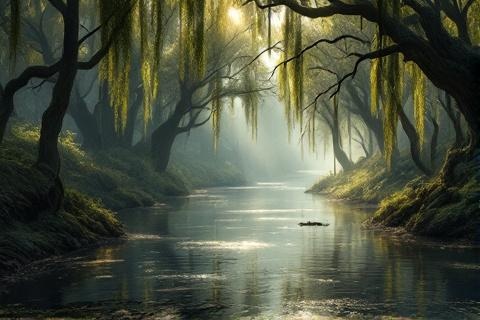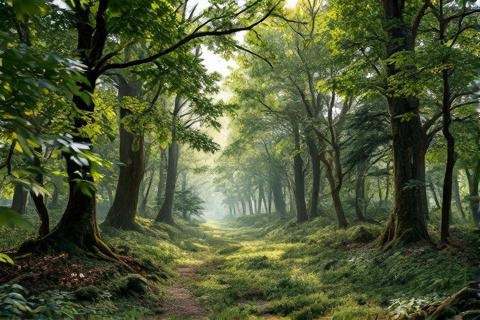
Into the Heart of the Old Forest: Mysterious Depths Beyond the Shire
How Tolkien's Enchanted Wood Became a Realm of Peril, Wonder, and Ancient Power
The Ancient Guardian of the Shire's Eastern Border

The Old Forest lies on the eastern border of the Shire,
specifically adjacent to Buckland. This ancient woodland stretches from the
Brandywine River's eastern bank, covering a considerable area that extends
towards the Barrow-downs. The forest's northern reaches gradually thin out
towards the Great East Road, while its southern portions merge with the shadowy
woodlands that once belonged to the realm of Cardolan.
The Old Forest stands as one of the last remnants of the vast primeval forests
that blanketed much of Eriador during the First Age. These
great woods once stretched from the Blue Mountains to the Misty Mountains,
forming part of the same forest system that included Fangorn Forest to the east.
Through the ages, as the realms of Men expanded and the power of
Arnor grew, much of this ancient woodland was gradually cleared,
leaving the Old Forest as an isolated pocket of that once-mighty expanse.
The Bucklanders, showing remarkable foresight and determination, constructed the
High Hay, also known as the Hedge, as a protective barrier against the forest's
malevolent influence. This impressive structure, maintained for generations,
rises over twenty feet high and extends for several miles along the forest's
western edge. The Hedge serves not only as a physical boundary but also as a
psychological barrier, separating the civilized lands of Buckland from the wild
and often dangerous forest beyond.
A Living, Breathing Woodland
The trees of the Old Forest possess an unusual level of consciousness and
mobility that sets them apart from ordinary woodlands. According to both
hobbit folklore and documented encounters, the trees can move
when unwatched, shifting their positions to hem in travelers or block familiar
paths. This awareness seems particularly strong in the older and more gnarled
specimens, which have developed over centuries of isolation and minimal
interference from the outside world.
Travelers in the Old Forest frequently report that paths which seemed straight
and clear suddenly twist and turn, leading them astray from their intended
direction. This disorienting effect appears deliberate rather than natural, as
the forest seems to actively work against those who attempt to traverse it. Even
experienced woodsmen have found themselves lost within its bounds, as landmarks
shift and familiar routes disappear overnight.
The atmosphere within the Old Forest is notably oppressive, characterized by an
almost tangible sense of watchfulness that unnerves even the most stoic
visitors. The air often grows thick and heavy, particularly in the deeper parts
of the forest, where ancient trees crowd closely together. This sensation of
being observed and unwelcome intensifies as one ventures further from the Hedge,
suggesting a gradient of hostility that increases toward the forest's heart.
The Withywindle Valley

At the forest's heart lies a concentration of the woodland's strange and ancient
powers, where the trees' awareness seems to reach its peak. This area, centered
around the Withywindle valley, manifests the strongest evidence of the forest's
sentience and its ability to influence those who enter its domain. The very air
here feels older and more enchanted than in other parts of the forest, heavy
with the weight of countless years and accumulated power.
The Withywindle River winds its way through the heart of the Old Forest, its
banks lined with ancient grey willows that seem to lean over the water with
peculiar intent. The river's course creates a natural pathway through the
forest's depths, though following its banks proves perilous due to the
particularly potent influence of the trees in this area. The water moves
sluggishly in places, creating deep pools where legends say ancient spirits
dwell.
Among the local inhabitants, particularly the hobbits of Buckland, the
Withywindle valley holds a fearsome reputation. Tales speak of travelers who
ventured too close to the river's banks and never returned, while others tell of
strange songs and voices carried on the wind. The Bucklanders maintain a healthy
respect for this area, warning their children to stay clear of the valley and
its mysterious inhabitants.
Old Man Willow's Domain

Old Man Willow, the most notorious tree in the forest, stands near a significant
bend in the Withywindle River. This ancient grey willow towers above its
neighbors, its massive trunk gnarled and twisted with age, while its long
branches trail into the water. The tree's immediate surroundings form a small
clearing, though the ground remains perpetually shadowed by its sprawling
canopy.
A peculiar drowsiness pervades the air around Old Man Willow, affecting both
people and animals who venture too close. This soporific atmosphere seems
strongest during warm afternoons, when the sun filters through the leaves and
the sound of the river creates a hypnotic effect. Many who have succumbed to
this drowsiness report strange dreams filled with whispered songs and ancient
memories.
The physical location of Old Man Willow serves as a natural focal point for the
forest's strange powers. The ground around the tree's massive roots remains
surprisingly dry despite its proximity to the river, while deep cracks and
hollows in its trunk suggest potential shelter that proves dangerously
deceptive. The willow's roots extend far into the riverbank, creating a complex
network that seems to pulse with the tree's malevolent awareness.
The Forgotten Paths
Ancient tracks still wind through the Old Forest, though they require keen eyes
to discern them from newer paths. These old ways, some dating back to the time
of Arnor, can be identified by their slight depression in the forest floor and
occasional remnants of stone marking posts. The most significant of these paths
once connected the North-South Road to settlements that have long since
vanished.
Scattered throughout the forest, observant travelers might notice weathered
stone markers and the occasional remnant of cobblestone, evidence of roads that
once served the kingdom of Cardolan. These fragments of civilization speak to a
time when the forest was less wild and more frequently traversed by the Men of
Westernesse. The trees have not completely obscured these
ancient thoroughfares, though they seem to resist any attempt to restore them.
Natural features such as distinctive rock formations, ancient oak groves, and
deep valleys still serve as waypoints for those few who know the forest's
secrets. The Withywindle River remains the most reliable landmark, though
following its course brings its own dangers. High points in the forest's terrain
occasionally offer glimpses of the Barrow-downs to the east, providing crucial
orientation for experienced travelers.
Flora and Fauna of the Forest

The Old Forest hosts a diverse array of tree species, with ancient oaks
dominating the higher ground and willows clustering along the Withywindle's
banks. Massive beeches and elms tower in the deeper parts of the forest, while
stands of pine and fir appear more frequently near its edges. These trees,
particularly the oldest specimens, exhibit unusual characteristics in both their
growth patterns and behavior.
The forest floor supports a rich understory of vegetation, including numerous
varieties of ferns, mosses, and flowering plants adapted to the deep shade.
Thick brambles often block the less-traveled paths, while ivy climbs many of the
older trees, sometimes reaching extraordinary sizes. The plant life seems
particularly vigorous near the Withywindle, though it takes on a more sinister
aspect in the river valley.
While wildlife exists within the Old Forest, animals tend to be secretive and
wary, reflecting the wood's mysterious nature. Birds are less numerous than in
other forests, though their songs can sometimes be heard in the canopy above.
Deer and other large mammals generally avoid the heart of the forest,
particularly the Withywindle valley, suggesting an instinctive awareness of the
dangers that lurk there.
A Forest Out of Time
The Old Forest shares many characteristics with the great forests of the First
Age, particularly in its semi-conscious nature and ability to defend itself
against outsiders. Like Fangorn Forest to the east, it retains elements of the
primeval woodlands that once covered vast stretches of
Middle-earth during the Elder Days. These connections
manifest in the forest's awareness and the ancient power that still resides
within its oldest trees.
Throughout the ages, the Old Forest has steadfastly resisted attempts at
civilization and change, maintaining its ancient character despite the
transformations occurring in the lands around it. This resistance extends beyond
mere natural resilience, suggesting a conscious effort to preserve its original
nature. The forest actively repels attempts to tame or alter it, as the hobbits
of Buckland have learned through generations of experience.
Within the Old Forest, particularly in its deepest regions, vestiges of power
from the Elder Days continue to manifest. These ancient forces, though
diminished from their original strength, remain potent enough to influence the
forest's character and behavior. The presence of such old powers links the
forest to the greater mythological history of Middle-earth, serving as a
reminder of the world's more enchanted past.
